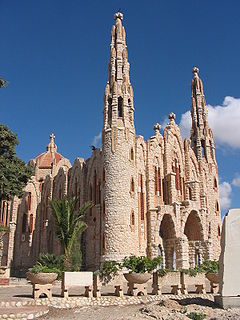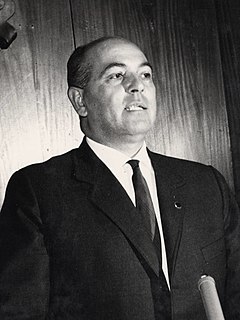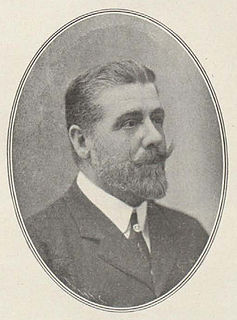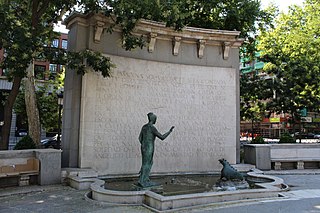
The Falange Española de las Juntas de Ofensiva Nacional Sindicalista, was a fascist political party founded in 1934 as merger of the Falange Española and the Juntas de Ofensiva Nacional-Sindicalista. The Falange Española de las JONS, which became the main Fascist group during the Second Spanish Republic, ceased to exist as such when, during the Civil War, General Francisco Franco merged it with the Traditionalist Communion in April 1937 to form the similarly named Falange Española Tradicionalista y de las JONS, which became the sole legal party in Spain until its dissolution in 1977.

The Spanish Syndical Organization, popularly known in Spain as the Sindicato Vertical, was the sole legal trade union for most of the Francoist dictatorship. A public-law entity created in 1940, the vertically-structured OSE was a core part of the project for frameworking the Economy and the State in Francoist Spain, following the trend of the new type of "harmonicist" and corporatist understanding of labour relations vouching for worker–employer collaboration developed in totalitarian regimes such as those of Nazi Germany and Fascist Italy in the first half of the 20th century. Up until the early 1950s, it internally worked—at least on a rhetorical basis—according to the discourse of national syndicalism. Previous unions, like the anarchist CNT and the socialist UGT, were outlawed and driven underground, and joining the OSE was mandatory for all employed citizens. It was disbanded in 1977.

Hispanidad is a term alluding to the group of people, countries, and communities that share the Spanish language and Hispanic culture. The term can have various, different implications and meanings depending on country of origin, socio-political views, and cultural background.

Juan Víctor Pradera Larumbe (1872–1936) was a Spanish political theorist and a Carlist politician.
Águila Roja is a Spanish adventure television series set in Spain during the 17th century. It was produced by Globomedia for Televisión Española and was broadcast on La 1 of Televisión Española from 2009 to 2016. It is one of the channel's most successful shows, and its rights have been sold to several countries.

The architecture of Madrid has preserved the look and feel of many of its historic neighbourhoods and streets, even though Madrid possesses a modern infrastructure. Its landmarks include the Royal Palace of Madrid, the Royal Theatre with its restored 1850 Opera House, the Buen Retiro Park, the 19th-century National Library building containing some of Spain's historical archives, a large number of national museums, and the Golden Triangle of Art located along the Paseo del Prado and comprising three art museums: Prado Museum, the Reina Sofía Museum, and the Thyssen-Bornemisza Museum, which completes the shortcomings of the other two museums. Cibeles Palace and Fountain have become the monument symbol of the city.
Alexandre-Mathieu Sureda Chappron was a Spanish architect. He worked under the name Alejandro Sureda and is considered "the main populariser of French architectural models amongst the Spanish aristocracy".

Joaquín Manglano y Cucaló de Montull, (1892-1985) was a Spanish entrepreneur, official, Catholic activist and politician. In terms of business he is known mostly as member of the Levantine economic oligarchy, in terms of officialdom as a Francoist mayor of Valencia (1939-1943) and a longtime Cortes deputy (1952-1967), in terms of Catholic activity as president of Legión Católica Española and in terms of politics as a Carlist. He was Grandee of Spain, 15. Baron of Cárcer, 2. Baron of Beniomer, 18. Baron of Llaurí, 6. Count of Burgo de Laverazo, 2. Marquis of Altamira de la Puebla, 13. Baron of Alcahalí de San Juan y Mosquera
Vicente Pascual Pastor was a spanish architect, one of the main architects of the Art Nouveau in Alcoy and the Valencian Art Nouveau.

Valencian Art Nouveau, is the historiographic denomination given to an art and literature movement associated with the Art Nouveau in the Valencian Community, in Spain.

José Solís Ruiz was a Spanish politician, known for his role in Francoist Spain, during which he occupied a number of important posts.
The Spanish Architecture Award is a prize which has been given biannually by the Consejo Superior de los Colegios de Arquitectos de España (CSCAE) since 1993.

Eduardo González Calleja is a Spanish historian, professor of Contemporary History at the Charles III University of Madrid (UC3M). He is the author of a long list of scholar works dealing with political violence.

Armando Muñoz Calero (1908–1978) was a Spanish physician and falangist politician. He was a member of the Cortes Españolas during the Francoist dictatorship, while he also served as president of the provincial government in Madrid and as deputy-mayor of the Madrid City Council.

José López Sallaberry was a Spanish architect and urbanist who worked in the Neoplateresca style.
The history of the far-right in Spain dates back to at least the 1800s and refers to any manifestation of far-right politics in Spain. Individuals and organizations associated with the far-right in Spain often employ reactionary traditionalism, religious fundamentalism, corporate Catholicism, and fascism in their ideological practice. In the case of Spain, according to historian Pedro Carlos González Cuevas, the predominance of Catholicism played an essential role in the suppression of external political innovations such as Social Darwinism, positivism, and vitalism in Spanish far-right politics.

The Monument to Calvo Sotelo is an instance of public art located in Madrid, Spain. Erected on the south of the Plaza de Castilla, it is dedicated to José Calvo Sotelo.

The Monument to Eugenio d'Ors Rovira is an instance of public art in Madrid, Spain. Dedicated to Eugenio d'Ors—noted Catalan writer, art critic and Francoist intellectual—it consists of a sculptural group put inside a fountain and a commemorative wall displaying a relief of d'Ors. It lies at the middle of the Paseo del Prado, facing both the Casa Sindical and the Prado Museum.
Emilio Bofill Benessat, in Catalan Emili Bofill i Benessat (1907-2000) was a Catalan builder with a strong background in architecture. He has been described as "the constructor whom every architect wanted to build their work." He was the father of Ricardo Bofill and Anna Bofill.














